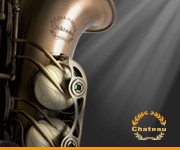 Forgot Username? Forgot Password?
Forgot Username? Forgot Password?
 BUFFET's History
BUFFET's History
A skilled instrument maker named Buffet-Auger, set up in 1825 his business right in the heart of Paris, Passage du GrandCerf (where still to-day Buffet-Crampon has its head-office and its sales warehouse), and he soon became known in musical circles by the outstanding quality of his clarinets made with 13 keys according to the Ivan Muller system which was then at the height of its fame. Like all his confreres, Buffet-Auger was a simple artisan who, with a few helpers whom he guided with great skill, worked like them almost entirely with his hands - as the mechanical side of the industry was then almost entirely nonexistent save for the pedal-lathe which as in the earlier centuries was the only mechanical aid available.
BUFFET-AUGER and his family specialized in the manufacture of clarinets, his son and younger brother (Louis-Auguste Buffet) being like himself past masters in this art. In 1830, Buffet-Auger left the firm to his son - who married in 1836 Miss Crampon - and who decided to add his wife's name to his own in order to distinguish himself from his uncle. As to the latter (Louis-Auguste), a tireless worker and with his head always full of ideas, he had the good fortune to link up with an exceptionally gifted clarinetist, Hyacinthe-Eleonor Klosé, whose fate it was to play an outstanding role in the history of his instrument. Klosé was born in 1808 in the island of Corfu but when still quite young he went to France in order to study music. After playing for a time in the band of the 6th regiment of the Royal Guards, he was appointed bandmaster to the 9th Light Infantry regiment, but resigned in 1836. During this time the young clarinetist had made astonishing progress in perfecting his virtuosity under the guidance of his teacher Friedrich Berr, Professor at the French Conservatoire, and when the latter died in 1838 Klosé was appointed to replace him, due to the reputation he had acquired. But Klosé was not only a virtuoso and an incomparable teacher, he had (like Louis-Auguste Buffet) an inquiring and inventive brain: so together they undertook to perfect the mechanism of the 13 key clarinet and they had the genial idea to apply to the instrument the system of articulated rings which the German Theobald Boehm (1794-1881) had invented for the flute. The problem proved far more complicated for the clarinet but the cooperation of the two friends enabled them to perfect their plans down to the smallest detail.
The new, or " Boehm " clarinet was thus born and brought before the public in 1839: it was immediately met with success among connoisseurs and in 1844 a patent was taken out under N° 16036. Naturally, as is the case with most inventions, criticisms and some obstruction were encountered on the part of certain artists who were used to the 13 key instrument, but the new system revealed itself so far superior, it overcame so many difficulties in the fingering of certain passages, trills and rapid runs which up to then it had been practically impossible to execute that it lost no time in taking a firm and permanent hold on the musical world, marking thus the end of the Ivan Muller instrument. The new " Boehm " system was thus adopted by all the different makers and Buffet-Crampon was naturally the first to exploit and to disseminate his uncle and Klosé's joint invention, for the greater joy of all clarinetists.
In 1850, due to the considerable progress which the business had accomplished, Buffet-Crampon went into partnership with his brother Louis and F. Tournier: and the same year it was found necessary to establish an atelier outside Paris concurrently with the one in the Passage du Grand-Cerf. In this way an entirely new industry was to make its appearance at Mantes-la-Jolie, a charming country spot about 35 miles west of Paris. Below, we explain how from this modest beginning an important factory was to be created.
FIVE years later, thus in 1855, Louis Buffet was replaced by P. Goumas. F. Tournier died in 1859 and it was then that a new company, Buffet-Crampon & Co., was formed between Buffet-Crampon, P. Goumas and the clarinetist Leroy, a pupil of Klosé. April 17th 1865 was a sad day for the business as it was marked by the death of the founder, Buffet-Crampon, and as Leroy had retired, P. Goumas remained alone at the head of the firm which, however, was never to drop the name of Buffet-Crampon so well known in the world of music. In that same year, 1865, the maestro Klosé, who had done such splendid work in renovating the art of the clarinet, was awarded the cross of the Legion of Honour by the Imperial Government. Three years later, at the age of sixty he retired from the Conservatoire, surrounded by the affection and esteem of his many pupils.
In 1871, P. Goumas took his two sons-in-law, Léon Legeay and Léon Crampon, into the business which had continued to develop, and the Mantes factory no longer limited its production to clarinets: all key instruments were turned out, including of course saxophones which were then quite a novelty. As one universal exhibition followed another, Buffet-Crampon carried off the highest awards and, in 1878, by a unanimous vote, the firm obtained the Gold Medal for its presentation of 42 instruments: complete families of clarinets and saxophones, oboes, flutes and bassoons. The jury declared moreover that all the instruments exposed were perfect, as well for pitch as for quality. And it was a joy for the veteran Klosé to witness this success, the triumph of the Boehm system which he had so ingeniously applied to the clarinet. Our virtuoso had still two years to live and, at the end of August 1880, he passed away peacefully in Paris.
ON July 1st 1885 Goumas was awarded the cross of the Legion of Honour in consecration of all the fine work he had accomplished. Then shortly after, in August of the same year, he turned over the management of the firm to Paul Evette and Ernest Schaeffer. Under these latter the reputation of the business continued to progress and, at the 1889 Exhibition, the only first prize granted went as a supreme award to Evette and Schaeffer who personified the fine old name of Buffet-Crampon. This outstanding success had as an immediate result the appointment of Buffet-Crampon in France as the official suppliers of wind instruments to the Paris Conservatoire National de Musique as also to its provincial branches and to various other musical academies in France: and to all this must be added the numerous and important overseas orders which the firm received.
PAUL Evette died on March 25th 1918 and the management of the business was passed on to his son Maurice who remained in charge until 1929. Upon his retirement a joint-stock company was formed with Mr. Paul E. Le Seigneur as chief executive, Gabriel Franot, an ex-regimental bandmaster, as business manager, while the technical management of the factory was assured by Paul Lefèvre. Gabriel Franot having died prematurely in the spring of 1938, Mr. P. E. Le Seigneur became sole manager of the new limited liability company which was then constitued and is still operative to-day, Mr. Robert Carrée having taken over the technical management of the Mantes factory upon the death of Paul Lefèvre.
We have shown in the preceding chapter that all the instruments were entirely made by hand when the business was founded in Paris in 1825. It is easy to imagine the high degree of manual skill which the artisans of that period had to attain in order to overcome all the problems and difficulties which faced them, and this state of things lasted quite a number of years. Little by little however certain rudimentary mechanical appliances enabled the first stages of the work to be done, after which however the instruments were finished by hand with the aid of the appropriate tools: files, pliers, gouges, fraises, saws, etc., while the keys were hammered out. All this shows again the skill of the men who carried out manually and so successfully such delicate work.
When, in 1850, Buffet-Crampon, his brother Louis and F. Tournier opened their workshop at Mantes, the staff consisted in all and for all of... three workmen! This was certainly a very slender beginning but the men in question were helped by a few of the local residents whom they had taught to make some of the auxiliary parts for the instruments, including the pads and springs. This work was done at home, and certain of these part-time helpers specialized in making keys, others took home the rudimentary wooden bodies of the instruments as they came off the lathe and ajusted the keys and the articulated rings, and it was only after this stage in the procedure that the precise calculations were made for boring the finger-holes : and all this of course was done by hand. The outcome of all this careful and skilled work was to produce a range of instruments attaining a comparatively high degree of precision but, after all, this could only be relative. Nevertheless, and allowing for the empiricism of the manufacturing methods employed - necessitating the occasional rejection of some part of the output as substandard - the firm succeeded in producing instruments of real quality, but only, of course, in strictly limited quantities. Every effort was made, however, by the management to deliver to its clients and artists nothing but high-class instruments.
It now became a vital necessity to find ways and means of increasing production and reducing overhead costs without in any way impairing the quality of the instruments. The introduction of machinery could alone solve this problem - which moreover was being felt throughout the whole field of manufacturing - and the time had come when the artisan had to yield his place to the oncoming tide of industry. Little by little machines of ever increasing precision were invented, and in the field of musical instrument production, Buffet-Crampon were always in the lead. At the first opportunity a steam-powered, 25 h.p. machine was installed in the Mantes factory, which at the time represented quite an achievement - although naturally in due course this was in turn replaced by more powerful electrical motors. After over 100 years in 1959, the modest workshop of 1850 had given place to an extended factory which employed more than one hundred specialists, without counting the outdoor staff who still work at home or in town for account of the firm. A rapid tour of the factory will enable us to better appreciate the many and varied aspects of its activity.
UNDER the capable guidance of Mr. Robert Carrée, technical manager of the plant, we can step back to 1959 and follow in detail the making of a clarinet from the raw material stage right up to the finished instrument. One must first of all note the two main elements in the fabrication: a) - all that concerns the wood, and b) - all that has to do exclusively with the metal. Therefore on the one hand we have the cabinet-making aspect, and on the other the metallurgical, and both follow a parallel course according to a rigorously established programme: the various operations are accomplished with methodical precision and when, in each of the two main subdivisions (wood and metal), the individual parts are completed, it is then possible to put the instrument together in its finished form.
Let us follow first the various transformations through which the wood passes, i.e. the basic ebony as it reaches the factory direct from East Africa. The wood as delivered has already been partially prepared, being cut into small segments for use as follows: the rectangular parallelepipeds, or " carrelets " measuring 37x 37x 275 millimetres, are destined for the lower body of the clarinets; others, 37x 37x 245 m/m are for the upper body of the instrument; some still smaller, viz. 37x 37x 70 m/m are for the barrels and finally the bells are carved from small blocks of ebony shaped like truncated pyramids and measuring 40x40 m/m at the top, 65x65 m/m at the bottom, and having a height of 120 m/m. Needless to say all the wood used is of the finest quality available.
ON reception all the woods are roughed out, shaped and drilled lengthwise on a special lathe. Then these bodies are ranged in the pigeon-holes of the wood storehouse where they will be left for drying in open air during about three years. The barrels and bells are in turn dressed and trimmed by lathe and bored; they are then grouped in chaplets, threaded on strings and also set aside in the wood storehouse to be left to dry like the other parts and for a similar period.
AFTER this long drying period, indispensable for the " stability " of the instruments, the bodies are then fashioned in order to undergo the ensuing stages of actual manufacture. The first operation is the drilling of the bore a little under the definitive dimensions for the reasons given later on. Then, on a planing lathe, the next operation is the preparation of the " épaulements ", or shoulder pieces, preliminary to carving the " bosses ". These latter consist of all those parts of the wooden framework which stand out from the body of the instrument itself, all the small protuberances necessary for piercing the lateral holes which receive a raised edge and which later will be hollowed out to receive the mobile metal ring, exactly fitted to its circular groove. The bosses are not fashioned at the outset, first the " épaulements " have to be prepared and carved, as indicated above.
To better understand what exactly is meant by these " épaulements ", or shoulder pieces, one can study the photos shown here. Fig. A represents the cylindrical wooden segment before the tooling operation which produces the " épaulements ". The segment is placed on a lathe which, in one moment, planes off all the parts where no bosses are foreseen; on the whole of this surface the diameter of the cylindrical tube will therefore be slightly reduced. The only portions remaining in relief will be the wooden circles, the concentrical rings, which can be seen on Fig. B and it is precisely out of these rings or circles - thicker than the adjacent parts which have been planed - that the bosses are fashioned. This operation is carried out by another lathe, invented by Buffet-Crampon, which carves off all the superfluous wood thus producing the new aspect as shown on Fig. C. These bodies or joints will be pumiced and oiled for a second period of drying which varies from 6 to 8 months. Yet another lathe is employed for tooling and shaping the extremities of the wooden joints into either sockets or tenons: the latter are subsequently covered with cork, thus ensuring the absolute stability and air-tightness of the joints throughout the whole body of the clarinet when all is finished and the instrument is ready for playing.
WHEN all the bosses have been formed on one body of the instrument, the next step is to pass on to the machine which bores all the lateral holes, as well as those destined later to produce the notes under the fingers of the artist, and also the small superficial cavities in which will be screwed the pivots of the rods, pivots which are called " boules " (tiny spheres). All the necessary notches are also marked out on the wood by the drilling machine in question, and it is fascinating to see this highly perfected instrument at work. Enormous progress has been realized over the work done formerly by hand for, whereas in the old days errors, and sometimes fairly obvious ones, could arise in the marking out of the holes, to-day such errors are absolutely impossible. The special aspect of this admirable machine is the large steel cylinder on which are marked, with the utmost precision, all the points where the holes, large or small, deep or shallow, have to be drilled. This cylinder, with its precious indications, revolves at the same speed, and on a parallel axis, as the piece of wood ready to be drilled. The rotation is not continuous and can be regulated by the workman charged with boring the holes with the appropriate bits - and following the indications of the cylinder - without the slightest risk of error. All the guiding marks are reproduced exactly on the wood, thus permitting the drilling to be accomplished with rigorously mathematical precision.
Not far from this drilling machine we can follow the " tapping " of all the small holes destined for the various screws: the threads are prepared rapidly on a special machine. When the drilling and tapping operations are over, the wooden bodies are ready to receive the pivots or " boules ". Then comes the shaping of the sonorous tube with " boring tools ". The calibre of these tools, sort of long steel bayonets, is minutely calculated according quotas which represent an important secret of manufacturing process. Each firm, each mark has its own special " bore " which plays an all-important role in the air-column which by its vibrations produces the sound. It is for these various reasons that the bores were " restrained " until this last operation which is trusted on a member of the " mastership ".
We come now into the metallurgical aspect of the question, but before going on a word must be said regarding the carving of the barrels and the bells of the instruments, and it is fascinating also to follow the work of the lathes whose function it is to perform these operations with a similar degree of precision. The graceful widening out of the bells and delicate curving of the barrels are accomplished as by enchantment, and the two operations are carried out faultlessly in less time than it takes to write it. These are further examples of the wizardry of our modern machine age.
On the metallurgical side of the manufacture of the instruments we come first to the pressing out of the nickel-silver keys: this is done by machines having a pressure of 45 tons. Subsequently the keys pass through another machine (pressure 35 tons), on which they are stamped into final or standard shape, each key espousing the outline of the matrix with such precision that all are interchangeable. The rings are cut out and stamped in similar fashion, after which operations we come to the welding of certain of the metal parts. This is done by hand, but very rapidly, thanks to the expert skill of the specialists involved. As to the pivots, or "boules ", they are tooled mechanically with the same overall precision.
A further remarkable feature is the machine which, in one operation and with the greatest speed, fraises all the pivots mounted on a supporting cylinder: sharp circular blades cut into these tiny " boules " and with extraordinary accuracy level down the faces destined to be mounted with the screws. The pivots are then drilled on another machine. Further still comes the polishing of all the metal accessories, - this operation being entrusted to very fast rotative machines which give a magnificent finish.
All the independant parts, once completed, are passed on to the mounters who adjust and assemble them by hand. The "tampons " or pads, of gold-beater's skin, are then fixed on as well as the various springs. The ebonite mouth-pieces having already been carved and polished, the cork is then affixed to the tenons: and when thus the clarinets are completly finished they are put aside on special trays-held upright by the bells on vertical supports, and are then ready to be tested by the clarinetist-virtuosi.
We have laid particular stress on the making of clarinets as these instruments constitute the major part of the output of the firm: but saxophones of the highest quality and workmanship are also manufactured by Buffet-Crampon in substantial quantities. The bodies of these instruments are cut by hand out of brass sheets and then shaped by mallet on appropriate mandrels but all the key work is done by machinery. The saxophones are then varnished in a kiln, after which they appear in all their opulant livery - a coat of golden lacquer, guaranteed of lasting quality. Other of the saxophones are silver-plated with or without a gilded bell, following the taste of the client. To-day the proportion of the former or gilt saxophones is well ahead of the silver-plated models.
The making of the flutes, oboes and bassoons is still done entirely by hand, the output of these latter instruments being far smaller. But all the work is carried out by qualified specialists and is capable of giving the fullest satisfaction to the most exacting artist, just as for the clarinets and saxophones.




